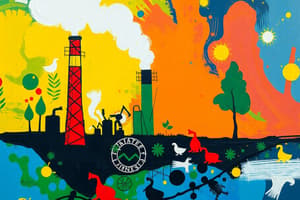Podcast
Questions and Answers
What are the three main types of Greenhouse gases?
What are the three main types of Greenhouse gases?
- Carbon Dioxide, Water Vapor, Methane and Nitrous Oxide (correct)
- Methane, Water Vapor, Nitrous Oxide and Ozone
- Carbon Dioxide, Oxygen, Nitrogen and Argon
- Ozone, Hydrogen, Helium and Radon
What is the difference between climate and weather?
What is the difference between climate and weather?
Climate refers to long-term averages of weather patterns, while weather describes short-term changes in the atmosphere.
What are the two main types of carbon pricing?
What are the two main types of carbon pricing?
- Carbon Tax and Reforestation
- Carbon Sequestration and Carbon Capture
- Emissions Trading System and Carbon Tax (correct)
- Climate Change Mitigation and Climate Change Adaptation
What is the goal of the Paris Agreement?
What is the goal of the Paris Agreement?
The Sun is the main cause of global warming.
The Sun is the main cause of global warming.
According to the IPCC, what is the best estimate of equilibrium climate sensitivity?
According to the IPCC, what is the best estimate of equilibrium climate sensitivity?
What is the main driver of future additional warming according to the IPCC report?
What is the main driver of future additional warming according to the IPCC report?
What is the global warming potential of methane, compared to carbon dioxide?
What is the global warming potential of methane, compared to carbon dioxide?
The ozone hole directly causes global warming.
The ozone hole directly causes global warming.
What is the estimated global investment in renewable energy capacity in 2018?
What is the estimated global investment in renewable energy capacity in 2018?
What is Nigeria's Intended Nationally Determined Contribution (INDC) target year?
What is Nigeria's Intended Nationally Determined Contribution (INDC) target year?
What is the primary focus of Nigeria's INDC?
What is the primary focus of Nigeria's INDC?
What is the estimated GHG emissions per capita in Nigeria for 2030 under the BAU scenario?
What is the estimated GHG emissions per capita in Nigeria for 2030 under the BAU scenario?
Flashcards
Global Warming
Global Warming
Long-term warming of the planet, a measure of climate change.
Climate Change
Climate Change
Broader term encompassing global warming, including changes in weather patterns, sea levels, and ice melt.
Weather
Weather
Local changes in climate, short-term (minutes to weeks).
Climate
Climate
Signup and view all the flashcards
Greenhouse Effect
Greenhouse Effect
Signup and view all the flashcards
Greenhouse Gases (GHGs)
Greenhouse Gases (GHGs)
Signup and view all the flashcards
Carbon Dioxide (CO2)
Carbon Dioxide (CO2)
Signup and view all the flashcards
Methane (CH4)
Methane (CH4)
Signup and view all the flashcards
Nitrous Oxide
Nitrous Oxide
Signup and view all the flashcards
Global Warming Potential (GWP)
Global Warming Potential (GWP)
Signup and view all the flashcards
Paris Agreement
Paris Agreement
Signup and view all the flashcards
IPCC Sixth Assessment Report
IPCC Sixth Assessment Report
Signup and view all the flashcards
Nationally Determined Contributions (NDCs)
Nationally Determined Contributions (NDCs)
Signup and view all the flashcards
Potential Policy Solutions
Potential Policy Solutions
Signup and view all the flashcards
Global Warming
Global Warming
Signup and view all the flashcards
Climate Change
Climate Change
Signup and view all the flashcards
Weather
Weather
Signup and view all the flashcards
Climate
Climate
Signup and view all the flashcards
Greenhouse Effect
Greenhouse Effect
Signup and view all the flashcards
Greenhouse Gases (GHGs)
Greenhouse Gases (GHGs)
Signup and view all the flashcards
Carbon Dioxide (CO2)
Carbon Dioxide (CO2)
Signup and view all the flashcards
Methane (CH4)
Methane (CH4)
Signup and view all the flashcards
Nitrous Oxide
Nitrous Oxide
Signup and view all the flashcards
Global Warming Potential (GWP)
Global Warming Potential (GWP)
Signup and view all the flashcards
Paris Agreement
Paris Agreement
Signup and view all the flashcards
IPCC Sixth Assessment Report
IPCC Sixth Assessment Report
Signup and view all the flashcards
Nationally Determined Contributions (NDCs)
Nationally Determined Contributions (NDCs)
Signup and view all the flashcards
Potential Policy Solutions
Potential Policy Solutions
Signup and view all the flashcards
Study Notes
Executive Summary
- Executive short-term courses in environmental standards.
- Track B: Proficiency certificate in environmental standards.
- Module 2, Day 9, Session 2.
- Topic: Global environmental change.
- Speaker: Dr. Maged Hamed, Ph.D., P.E., Regional Safeguard Coordinator and Co-TTL of SPESSE.
- Location: The Environment Global Practice of the West and Central Africa - SAWE4.
- Date: March 2022.
Course Content
- Definition of global warming, climate change, weather.
- Greenhouse gas (GHG) effect and how they work.
- Common greenhouse gases.
- Contribution of GHGs to climate change.
- Effects caused by global warming.
- Global warming potential (GWP).
- The Paris Agreement.
- The Sixth Assessment Report of the IPCC in 2021.
- Potential policy solutions.
- Nigeria's Intended Nationally Determined Contribution.
Climate Change vs Global Warming
- Global warming: Long-term warming of the planet, measured by the average global temperature.
- Climate change: A broader range of changes on Earth, including rising sea levels, glacial melting, and shifts in plant blooming times; caused by human activities.
- The sun influences Earth's climate, but it isn't responsible for recent warming trends.
Weather vs Climate
- Weather: Local changes in climate, occurring over short timescales (minutes to weeks). Examples include rain, snow, clouds.
- Climate: Longer-term averages, typically over several decades. Represents typical, expected conditions in a region.
Greenhouse Gases
- Greenhouse effect: The trapping of heat near Earth's surface by greenhouse gases. The gases act like a blanket, keeping the planet warmer than it would be otherwise.
- Key greenhouse gases: Carbon dioxide, Methane, Nitrous oxides.
- Without these gases, Earth's temperature would be below freezing.
- Carbon dioxide levels have been consistently rising for decades, trapping more heat near Earth's surface.
Common Greenhouse Gases
- Multiple types of greenhouse gases exist.
- Major ones are carbon dioxide, water vapor, methane, and nitrous oxide.
- These gases are made of three or more atoms bonded loosely enough to vibrate when heat is absorbed.
- This vibration releases radiation, which is often absorbed by another greenhouse gas molecule, keeping the heat trapped in the atmosphere.
- Nitrogen and oxygen, the most abundant gases in Earth's atmosphere, do not absorb heat and do not contribute significantly to the greenhouse effect.
- Carbon dioxide (CO2): Made of one carbon atom and two oxygen atoms; comprises a small fraction of the atmosphere but significantly affects climate; about 270 parts per million (ppm) in the mid-19th century and currently about 400 parts per million (ppm).
- Methane (CH4): Made of one carbon atom and four hydrogen atoms; A powerful greenhouse gas, 30 times stronger than CO2. It breaks down faster than CO2.
- Nitrous oxide (N2O): Helps plants grow but is a potent greenhouse gas; 300 times stronger than CO2.
- Fluorinated gases: Synthetic gases used in refrigerants, foams, and aerosols; potent greenhouse gases and not natural; typically account for a small percentage of greenhouse gas emissions (3%) but very effective at warming (23,000 times stronger than CO2).
Global Warming Potential (GWP)
- Global warming potential (GWP): Represents how much heat a gas absorbs in the atmosphere compared to carbon dioxide over a given time frame. A unit used to compare the impact of different gases.
- GWP for CO2 is 1. Other gases have much higher GWPs (e.g., methane and nitrous oxide).
The Paris Agreement
- Legally binding international treaty on climate change adopted in 2015.
- Goal is to limit global warming to well below 2 degrees Celsius, preferably to 1.5 degrees Celsius, compared to pre-industrial levels.
- Countries aim to reach global peaking of greenhouse gas emissions soon to achieve a climate neutral world by mid-century.
- Countries submit plans for climate action (Nationally Determined Contributions-NDCs).
- The agreement works on a five-year cycle, aiming to increase climate action.
The Sixth Assessment Report of the IPCC, 2021
- Human influence has unequivocally warmed the atmosphere, ocean, and land.
- The scale of recent changes across climate systems is unprecedented.
- Human-induced climate change is already affecting weather and climate extremes globally, such as heatwaves, intense precipitation, droughts, and tropical storms.
- Climate sensitivity (warming per unit increase of radiative forcing) is ~3°C.
World GHG Emissions (2019)
- Global GHG emissions: 38,016.47 million tonnes.
- Key countries and their GHG emissions per capita. (Data provided in tables)
Nigeria's Intended Nationally Determined Contribution (INDC)
- Nationally determined goals/targets to reduce greenhouse gases.
- Objectives and summary measures.
- Conditional vs. unconditional measures for reducing emissions.
- Projected emissions, historical emissions, and commitments.
- Key measures, plans, and targets (tables)
Potential Policy Solutions
- Price carbon pollution (carbon pricing): Pricing carbon emissions to reduce pollution.
- Emissions trading systems (ETS), carbon tax(taxing GHG emissions)
- Shift to electric vehicles (EVs)
- Commitment by corporations to carbon reduction.
Investments Required and Renewable Energy in 2018
- Global investment in renewable energy capacity in 2018.
- Countries with high investments in renewable energy.
Summary of Possible Climate Futures
- Global surface temperature will continue to increase until at least the mid-century, depending on emissions.
- Global warming of 1.5°C and 2°C will likely be exceeded by the end of the century unless significant emissions reduction take place.
- Many changes in the climate system are larger in direct relation to increasing global warming. Many changes are irreversible for centuries.
Limiting Future Climate Change
- Limiting human-induced global warming requires limiting cumulative carbon dioxide emissions.
- Strong, rapid and sustained reductions in other greenhouse gas emissions are also required.
- Scenarios with low or very low greenhouse gas (GHG) emissions can produce discernible effects on gas and aerosol concentrations and air quality compared to high emission scenarios.
Nigeria: Contribution to GHG per capita
- Data on Nigeria's contribution to global emissions (2015, 2019).
Potential GHG Reduction Measures (by Sector)
- Summary of potential policies to reduce greenhouse gas emissions in Nigeria.
Source of 2030 Emission Reduction (by Sector)
- Summary pie chart of sources of emission reductions.
Studying That Suits You
Use AI to generate personalized quizzes and flashcards to suit your learning preferences.




